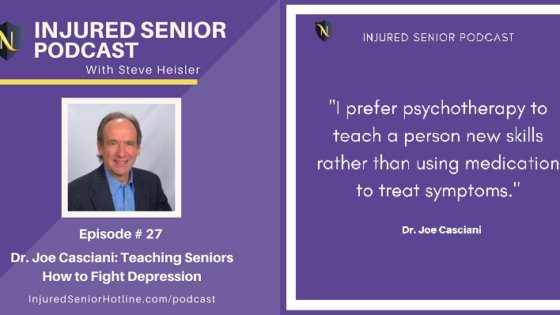by Joe Casciani
It’s been said that psychology, historically, has attempted to understand and help people by focusing on problems and dysfunction. Positive psychology is different; it instead examines how the average person can be happier and lead a more tranquil, satisfying life. Positive psychology encourages people to identify and develop their own positive emotions, experiences, personal strengths, and traits, and reverse the focus from negative to positive. If we can shift attention to the positive aspects of our work or family life, such as by thinking about what went right during the day, instead of where I didn’t perform perfectly, then we can bring a better balance between the positive and negative, be more effective in our interactions, communications, and relations with others, and develop a more optimistic outlook toward the future.
It is important to state here that positive psychology is more than putting on “rose-colored glasses.” It is a process of learning to view, explain, and interpret events in a positive frame of mind and apply this new outlook to our day-to-day interactions.
This article was originally written as an inservice overview for nursing home staff, and is re-printed here with a few modifications. This is the first of two articles devoted to this topic. In this, we describe basic principles of positive psychology and how our “explanatory style” can shift from negative to positive. Part two will focus on the concept of “re-framing” and how changing our thinking patterns can change how we experience different events.
PRINCIPLES OF POSITIVE PSYCHOLOGY
| “Whether you think you can or you can’t, either way you are right.” Henry Ford |
This quote from one of the greatest American inventors and manufacturers captures an underlying principle of positive psychology: Our thoughts influence so much of who we think we are, what we are capable of, our self-image, and so on, and changing our thoughts, in effect, can change our entire self-image. Here are some fundamental principles used in Positive Psychology:
- We choose how we respond: It is not possible to always control the events in our lives, but it is possible to control our reactions. We can choose how we want to respond to these events, and we know responding in a positive, constructive manner is more valuable than a negative reaction. A simple example is our response when someone cuts us off in traffic – this is a good indicator of how we choose to react. Do we personalize that event, “Why is she so reckless and inconsiderate of me!” or do we react with a more measured, reasoned response, “She’s probably reckless with everyone on the road.”
- We can reverse the focus from negative to positive: We can control, change, and redirect our thoughts away from negative, self-limiting self-talk and toward more positive, self-enhancing thoughts that enhance our self-confidence, personal well-being, and happiness. If I used harsh words with a co-worker out of frustration or fit of anger, it does no good to berate myself or dwell on being a mean person. Instead, I can use my thoughts to understand what triggered my reaction and make an effort to communicate in more constructive and less emotional ways.
- We can find the positive events: Reflecting on the positive experiences of the day is a calming activity, especially as we retire for the evening. If we take the time to recall a few positive events in our day that we experienced or caused, we will experience peace, calmness, and confidence as we go off to sleep.
- Finding the positive in others: Positive psychology also means looking for and complimenting the positive qualities – appearance, actions, cooperative attitudes – that we observe in others. In this way, we enhance the lives of others and create positive feelings for ourselves in return.
- We are today the result of our past thinking, and we shall become what we are thinking today. Positive psychology uses the Law of Attraction as a major principle: Law of Attraction brings us what we have created with our own thought processes; like attracts like. In other words, we are consistently creating and re-creating ourselves.
| William James, Father of American Psychology, once said “Our belief at the beginning of an undertaking is the one thing that insures the successful outcome of your venture. The greatest discovery of my generation is that human beings can alter their lives by altering their attitudes of mind.” |
EXPLANTORY STYLE – POSITIVE OR NEGATIVE
Explanatory style refers to how people explain the events of their lives, or how we interpret events, or how we can explain a situation. Explanatory style leans toward either optimism or pessimism. Optimists have a positive explanatory style, or a positive way of explaining events in their lives. And pessimists have the opposite, or a negative explanatory style.
- Optimists explain positive events as having happened because of them. They also see events as evidence that more positive things will happen in the future (events are stable and unchanging), and in other areas of their lives (on a global level across one’s life).
- Optimists maintain a “try again” mindset, which makes them more likely to succeed in the future and are less upset by failure.
- Pessimists tend to blame themselves when things go wrong and are more reluctant to try again with each negative experience in life. They interpret neutral events as negative. They see positive events in their lives as exceptions that have nothing to do with them, and expect the worst later on. In this way, optimists and pessimists both create self-fulfilling prophecies.
In other words, what you think about, you bring about!
| Here is a simple exercise to highlight the optimist vs. pessimist perspective. First, put on the optimist’s hat, and look around the room you are in right now, and find things that an optimist would notice – the comfortable furniture, the useful objects lying around, the room colors, the plants, and so on. Now, change hats and see the same room from a pessimist’s perspective – the clutter, the sounds, the glare or darkness, maybe dirt or dust, marks on the walls, and so on. So, the same room but two different takes on the same space. Which hat are we wearing throughout our day? |
One closing thought that highlights the Positive Psychology approach. It’s from a quote by George Matthew Adams, an American newspaper columnist: Learn to keep the door shut, keep out of your mind, out of your head, and out of your world, every element that seeks admittance with no definite helpful end in view.
THIS WEEKS’ RECOMMENDATIONS
The Living to 100 Club, LLC, is an Amazon Affiliate; sales commissions accrue to the Company when recommended Amazon products are purchased by our readers. These products target healthy lifestyles, information on successful aging, and aid to caregivers.
The Happiness Advantage: How a Positive Brain Fuels Success – The Happiness Advantage isn’t only about how to become happier at work. It’s about how to reap the benefits of a happier and more positive mind-set to achieve the extraordinary in our work and in our lives.
![The Happiness Advantage: How a Positive Brain Fuels Success in Work and Life by [Achor, Shawn]](https://images-na.ssl-images-amazon.com/images/I/41obIJ-AVIL.jpg)
Activities for Teaching Positive Psychology: A Guide for Instructors – presents a comprehensive set of fun, interactive classroom activities devised by contributors who are experienced teachers as well as leading scholars in their areas.

The Positive Shift: Mastering Mindset to Improve Happiness, Health, and Longevity – The truth is, the way we think about ourselves and the world around us dramatically impacts our happiness, health, how fast or slow we age, and even how long we live. In fact, people with a positive mindset about aging live on average 7.5 years longer than those without.

Essentialism: The Disciplined Pursuit of Less – By forcing us to apply a more selective criteria for what is Essential, the disciplined pursuit of less empowers us to reclaim control of our own choices about where to spend our precious time and energy—instead of giving others the implicit permission to choose for us.





